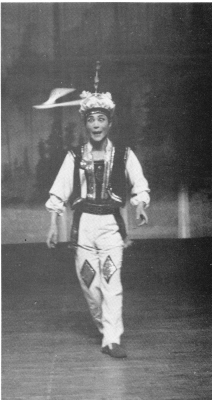|
I
have developed flying board skills into five types: hurling,
catching, hitting, bouncing and falling. These are mastered
through many years of artistic practice.
HURLING:
1) Throwing one board to the right and one to the left at the
same time. The two pass in mid-flight and continue back to the
thrower. 2) Throwing three parallel boards at the same time,
making them fly high, middle and low so that they look like
the silver swallows flying in formation. 3) Throwing four
boards at the same time with different force. When the first
is caught, throw it immediately as before and continue to
catch and throw again each one. The four flying boards will
form a moving vase in the air. 4) Throw six boards one by one
and catch them as they return. 5) Throw four boards in
succession and turn a somersault before catching them.
CATCHING:
1) "A Baby Waving Hands" is throwing three boards in
succession from two hands. The hands catch the first two to
return, and the third is caught on a toy baby's head. While
the three continue to spin, the baby waves its hands at the
audience through means of a control in the performer's mouth.
2) "Full Blossom on Four Sides" is throwing two
boards from each hand in succession. Catch the first two in
each hand, the third on the head and the fourth on the tip of
the toe.
HITTING:
1) "Hitting the Flower" is when a returning board
knocks a flower out of the mouth of an assistant and returns
to the performer's hand. 2) Throw a twowinged board that
knocks a flower off of the performer's hat when it returns to
him. He then catches it in his hand.
BOUNCING:
The above skills are performed by hands. Bouncing is acted out
by carrying a miniboard on one hand and flicking it up. The
board will rebound to the actor's hand.
FALLING:
"A Phoenix Seeking Her Nest." After the flying board
leaps out, it falls to the intended spot without fault and
continues to spin.
I
hope to discuss with my counterparts from each country the
making of the flying boards, training of actors, creation of
new movements and other aspects to improve acrobatics on an
international scale. "
If
you would like to find out more, you may write Dai Shucheng
c/o Hei Long Jiang Acrobatics Troupe, Ha Er Bin, China.
|

